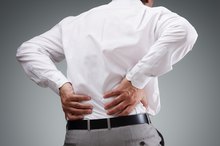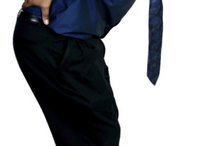What Are the Causes of Sharp Shooting Hip Pain Running Down Leg?
Shooting pain that starts in the hip and runs down the leg is often labeled as sciatica. **Technically, sciatica is a specific type of nerve pain.
If you are experiencing serious medical symptoms, seek emergency treatment immediately.
** While sciatica is a frequent culprit in radiating leg pain, other potential pain sources include problems originating in muscles, joints or bursae. Identifying patterns in the pain and related symptoms can help determine the source of the pain and set the course for recovery.
Nerve Pain
Sciatica is a nerve pain caused by compression or inflammation of a nerve in the lower back or buttock region. Pain is usually quite sharp in the buttock area and often runs down the leg all the way to the foot. The pain increases when tension is placed on the sciatic nerve. Radiating pain that is dramatically increased when lying face up and raising a straight leg suggests sciatica. Nerve compression or inflammation may also cause numbness or weakness in the involved leg. When radiating pain is increases by leg raising and is coupled with numbness or weakness, a sciatic nerve problem is the likely culprit according to a clinical review published in the "British Medical Journal" in June, 2007 1.
- Sciatica is a nerve pain caused by compression or inflammation of a nerve in the lower back or buttock region.
- When radiating pain is increases by leg raising and is coupled with numbness or weakness, a sciatic nerve problem is the likely culprit according to a clinical review published in the "British Medical Journal" in June, 2007 1.
Muscle Pain
Causes of Hip Pain in a 35 Year Old Female
Learn More
A strain or cramp in a hamstring muscle can certainly be painful. Usually a hamstring injury occurs suddenly during an activity like high speed running.
(ref. 2) The focal point of the pain is often where the hamstring attaches to the pelvis.
This portion of the pelvis is sometimes called the "sit bone" because of its location at the lower margin of the buttock. The pain will radiate along the course of the hamstring muscle in the back of the thigh. There is usually no pain below the knee and no numbness.
- A strain or cramp in a hamstring muscle can certainly be painful.
- 2) The focal point of the pain is often where the hamstring attaches to the pelvis.
Joint Pain
Inflammation or arthritis of the hip joint often manifest as pain in the groin that radiates down the front and inner portion of the thigh. A study published in January, 2008 in the journal "Pain Medicine" specifically assessed pain referral patterns from the hip joint 3.
Authors of the study found that over 50 percent of the time, the pain is felt in the groin and front of the thigh. Over 70 percent of the subjects had pain in the buttock and in just over 20 percent, the pain ran past the level of the knee into the lower leg.
Logically, pain coming from the hip joint is increased when the joint is placed in a position of stress. Sitting cross-legged on the floor, for example, is likely to be uncomfortable or even impossible for a person with significant hip joint arthritis or inflammation.
- Inflammation or arthritis of the hip joint often manifest as pain in the groin that radiates down the front and inner portion of the thigh.
- Authors of the study found that over 50 percent of the time, the pain is felt in the groin and front of the thigh.
Bursa Pain
Sciatica & Weight Loss
Learn More
The trochanteric bursa lies over a bony knob along the outside of the hip. This knob serves as an attachment point for several powerful muscles that move and stabilize the hip. **Bursitis, or inflammation of this bursa, can cause sharp pain.
When the bursa is very inflamed, there is often tightness and tenderness traveling along the course of the iliotibial band, a dense, fibrous connective tissue band that runs along the outside of the thigh to a point just below the knee. ** The most sharply tender area will be at the point of the hip on its outside edge. Lesser tenderness runs down along the outside edge of the thigh.
(Ref. 4) This pain may interfere with sleep, especially when lying on the tender side. Standing up after prolonged sitting may be painful. Squatting, stair climbing and prolonged walking may also increase this pain. (Ref. 4)
- The trochanteric bursa lies over a bony knob along the outside of the hip.
- Bursitis, or inflammation of this bursa, can cause sharp pain.
Related Articles
References
- British Medical Journal: Diagnosis and Treatment of Sciatica; 2007
- Journal of Orthopedic and Sports Physical Therapy: Hamstring Strain Injuries: Recommendations for Diagnosis, Rehabilitation and Injury Prevention; 2010
- Pain Medicine: Hip Joint Pain Referral Patterns: A Descriptive Study; 2008
- American Academy of Orthopaedic Surgeons: Hip Bursitis
- Seidman AJ, Varacallo M. Trochanteric Bursitis. [Updated 2019 Mar 10]. In: StatPearls [Internet]. Treasure Island (FL): StatPearls Publishing; 2019 Jan-.
- Musick SR, Varacallo M. Snapping Hip Syndrome. [Updated 2019 Apr 16]. In: StatPearls [Internet]. Treasure Island (FL): StatPearls Publishing; 2019 Jan-.
- Smith RB III. Claudication. In: Walker HK, Hall WD, Hurst JW, editors. Clinical Methods: The History, Physical, and Laboratory Examinations. 3rd edition. Boston: Butterworths; 1990. Chapter 13.
- Plante M, Wallace R, Busconi BD. Clinical diagnosis of hip pain. Clin Sports Med. 2011;30(2):225-38. doi:10.1016/j.csm.2010.12.003
- Wilson JJ, Furukawa M. Evaluation of the patient with hip pain. Am Fam Physician. 2014;89(1):27-34. PMID: 24444505
- Gold M, Varacallo M. Anatomy, Bony Pelvis and Lower Limb, Hip Joint. [Updated 2019 Apr 6]. In: StatPearls [Internet]. Treasure Island (FL): StatPearls Publishing; 2019 Jan-.
- Byrd JW. Evaluation of the hip: history and physical examination. N Am J Sports Phys Ther. 2007;2(4):231–240. PMID: 21509142
- Battaglia PJ, D'Angelo K, Kettner NW. Posterior, Lateral, and Anterior Hip Pain Due to Musculoskeletal Origin: A Narrative Literature Review of History, Physical Examination, and Diagnostic Imaging. J Chiropr Med. 2016;15(4):281–293. doi:10.1016/j.jcm.2016.08.004
- Hamer AJ. Pain in the hip and knee. BMJ. 2004;328(7447):1067–1069. doi:10.1136/bmj.328.7447.1067
- Lespasio MJ, Sultan AA, Piuzzi NS, et al. Hip Osteoarthritis: A Primer. Perm J. 2018;22:17–084. doi:10.7812/TPP/17-084
- Neogi T. The epidemiology and impact of pain in osteoarthritis. Osteoarthritis Cartilage. 2013;21(9):1145–1153. doi:10.1016/j.joca.2013.03.018
- Kim Y, Oh HC, Park JW, et al. Diagnosis and Treatment of Inflammatory Joint Disease. Hip Pelvis. 2017;29(4):211–222. doi:10.5371/hp.2017.29.4.211
- Bateman L, Vuppala S, Porada P, et al. Medical management in the acute hip fracture patient: a comprehensive review for the internist. Ochsner J. 2012;12(2):101–110. PMID: 22778674
- Nazem TG, Ackerman KE. The female athlete triad. Sports Health. 2012;4(4):302–311. doi:10.1177/1941738112439685
- Pisani P, Renna MD, Conversano F, et al. Major osteoporotic fragility fractures: Risk factor updates and societal impact. World J Orthop. 2016;7(3):171–181. Published 2016 Mar 18. doi:10.5312/wjo.v7.i3.171
- Williams CH, Sternard BT. Bursitis. [Updated 2019 Sep 11]. In: StatPearls [Internet]. Treasure Island (FL): StatPearls Publishing; 2019 Jan-.
- Tyler TF, Fukunaga T, Gellert J. Rehabilitation of soft tissue injuries of the hip and pelvis. Int J Sports Phys Ther. 2014;9(6):785–797. PMID: 25383247
- Reiman MP, Thorborg K. Clinical examination and physical assessment of hip joint-related pain in athletes. Int J Sports Phys Ther. 2014;9(6):737–755. PMID: 25383243
- Zapparoli FY, Riberto M. Isokinetic Evaluation of the Hip Flexor and Extensor Muscles: A Systematic Review. J Sport Rehabil. 2017;26(6):556-566. doi:10.1123/jsr.2016-0036
- Dallinga JM, Benjaminse A, Lemmink KA. Which screening tools can predict injury to the lower extremities in team sports?: a systematic review. Sports Med. 2012;42(9):791-815. doi:10.1007/bf03262295
- Tyler TF, Nicholas SJ. Rehabilitation of extra-articular sources of hip pain in athletes. N Am J Sports Phys Ther. 2007;2(4):207–216. PMID: 21509140
- Lespasio MJ, Sodhi N, Mont MA. Osteonecrosis of the Hip: A Primer. Perm J. 2019;23:18-100. doi:10.7812/TPP/18-100
- An YS, Park S, Jung JY, Suh CH, Kim HA. Clinical characteristics and role of whole-body bone scan in multifocal osteonecrosis. BMC Musculoskelet Disord. 2019;20(1):23. Published 2019 Jan 15. doi:10.1186/s12891-019-2401-y
- Nakamura J, Konno K, Orita S, et al. Distribution of hip pain in patients with idiopathic osteonecrosis of the femoral head. Mod Rheumatol. 2017;27(3):503-507. doi:10.1080/14397595.2016.1209830
- Groh MM, Herrera J. A comprehensive review of hip labral tears. Curr Rev Musculoskelet Med. 2009;2(2):105–117. doi:10.1007/s12178-009-9052-9
- Pun S, Kumar D, Lane NE. Femoroacetabular impingement. Arthritis Rheumatol. 2015;67(1):17–27. doi:10.1002/art.38887
- Zhang C, Li L, Forster BB, et al. Femoroacetabular impingement and osteoarthritis of the hip. Can Fam Physician. 2015;61(12):1055–1060. PMID: 26668284
- Long B, Koyfman A, Gottlieb M. Evaluation and Management of Septic Arthritis and its Mimics in the Emergency Department. West J Emerg Med. 2019;20(2):331–341. doi:10.5811/westjem.2018.10.40974
- Shirtliff ME, Mader JT. Acute septic arthritis. Clin Microbiol Rev. 2002;15(4):527–544. doi:10.1128/cmr.15.4.527-544.2002
- Mantyh PW. Bone cancer pain: from mechanism to therapy. Curr Opin Support Palliat Care. 2014;8(2):83–90. doi:10.1097/SPC.0000000000000048
- Lipton A, Uzzo R, Amato RJ, et al. The science and practice of bone health in oncology: managing bone loss and metastasis in patients with solid tumors. J Natl Compr Canc Netw. 2009;7 Suppl 7(Suppl 7):S1–S30. doi:10.6004/jnccn.2009.0080
- Grumet RC, Frank RM, Slabaugh MA, Virkus WW, Bush-Joseph CA, Nho SJ. Lateral hip pain in an athletic population: differential diagnosis and treatment options. Sports Health. 2010;2(3):191–196. doi:10.1177/1941738110366829
- Seidman AJ, Varacallo M. Trochanteric Bursitis. [Updated 2019 Mar 10]. In: StatPearls [Internet]. Treasure Island (FL): StatPearls Publishing; 2019 Jan-.
- Reid D. The management of greater trochanteric pain syndrome: A systematic literature review. J Orthop. 2016;13(1):15–28. Published 2016 Jan 22. doi:10.1016/j.jor.2015.12.006
- Musick SR, Varacallo M. Snapping Hip Syndrome. [Updated 2019 Apr 16]. In: StatPearls [Internet]. Treasure Island (FL): StatPearls Publishing; 2019 Jan-.
- Lavine R. Iliotibial band friction syndrome. Curr Rev Musculoskelet Med. 2010;3(1-4):18–22. Published 2010 Jul 20. doi:10.1007/s12178-010-9061-8
- Lewis CL. Extra-articular Snapping Hip: A Literature Review. Sports Health. 2010;2(3):186–190. doi:10.1177/1941738109357298
- Winston P, Awan R, Cassidy JD, Bleakney RK. Clinical examination and ultrasound of self-reported snapping hip syndrome in elite ballet dancers. Am J Sports Med. 2007;35(1):118-26. doi:10.1177/0363546506293703
- Frank RM, Slabaugh MA, Grumet RC, Virkus WW, Bush-Joseph CA, Nho SJ. Posterior hip pain in an athletic population: differential diagnosis and treatment options. Sports Health. 2010;2(3):237–246. doi:10.1177/1941738110366000
- Vleeming A, Schuenke MD, Masi AT, Carreiro JE, Danneels L, Willard FH. The sacroiliac joint: an overview of its anatomy, function and potential clinical implications. J Anat. 2012;221(6):537–567. doi:10.1111/j.1469-7580.2012.01564.x
- Moscote-Salazar LR, Alvis-Miranda HR, Joaquim AF, Amaya-Quintero J, Padilla-Zambrano HS, Agrawal A. Sacroiliac Pain: A Clinical Approach for the Neurosurgeon. J Neurosci Rural Pract. 2017;8(4):622–627. doi:10.4103/jnrp.jnrp_171_17.
- Martin HD, Reddy M, Gómez-Hoyos J. Deep gluteal syndrome. J Hip Preserv Surg. 2015;2(2):99–107. doi:10.1093/jhps/hnv029
- Wagner T. A rare cause of hip pain characterized by an inability to walk or bear weight. JAAPA. 2011;24(9):34, 36-7. doi:10.1097/01720610-201109000-00006
- Martin HD, Palmer IJ. History and physical examination of the hip: the basics. Curr Rev Musculoskelet Med. 2013;6(3):219–225. doi:10.1007/s12178-013-9175-x
- Wilson CH. The Musculoskeletal Examination. In: Walker HK, Hall WD, Hurst JW, editors. Clinical Methods: The History, Physical, and Laboratory Examinations. 3rd edition. Boston: Butterworths; 1990. Chapter 164.
- Poultsides LA, Bedi A, Kelly BT. An algorithmic approach to mechanical hip pain. HSS J. 2012;8(3):213–224. doi:10.1007/s11420-012-9304-x
- Fujita K, Kabata T, Kajino Y, et al. Quantitative analysis of the Trendelenburg test and invention of a modified method. J Orthop Sci. 2017;22(1):81-88. doi:10.1016/j.jos.2016.09.007
- Deleanu B, Prejbeanu R, Tsiridis E, et al. Occult fractures of the proximal femur: imaging diagnosis and management of 82 cases in a regional trauma center. World J Emerg Surg. 2015;10:55. Published 2015 Nov 18. doi:10.1186/s13017-015-0049-y
- Annabell L, Master V, Rhodes A, Moreira B, Coetzee C, Tran P. Hip pathology: the diagnostic accuracy of magnetic resonance imaging. J Orthop Surg Res. 2018;13(1):127. Published 2018 May 29. doi:10.1186/s13018-018-0832-z
- Henderson RE, Walker BF, Young KJ. The accuracy of diagnostic ultrasound imaging for musculoskeletal soft tissue pathology of the extremities: a comprehensive review of the literature. Chiropr Man Therap. 2015;23:31. Published 2015 Nov 5. doi:10.1186/s12998-015-0076-5
- Fritz JM, McDonald JR. Osteomyelitis: approach to diagnosis and treatment. Phys Sportsmed. 2008;36(1):nihpa116823. doi:10.3810/psm.2008.12.11
- Chung C, Stern PJ, Dufton J. Urolithiasis presenting as right flank pain: a case report. J Can Chiropr Assoc. 2013;57(1):69–75. PMID: 23483000
- Cheatham SW, Kolber MJ, Salamh PA. Meralgia paresthetica: a review of the literature. Int J Sports Phys Ther. 2013;8(6):883–893. PMID: 24377074
- Parisi TJ, Mandrekar J, Dyck PJ, Klein CJ. Meralgia paresthetica: relation to obesity, advanced age, and diabetes mellitus. Neurology. 2011;77(16):1538–1542. doi:10.1212/WNL.0b013e318233b356
- Son BC, Kim DR, Kim IS, Hong JT, Sung JH, Lee SW. Neurolysis for meralgia paresthetica. J Korean Neurosurg Soc. 2012;51(6):363–366. doi:10.3340/jkns.2012.51.6.363
- Kita K. Leriche syndrome (Aortoiliac occlusive disease). J Gen Fam Med. 2017;18(5):297–298. Published 2017 Apr 21. doi:10.1002/jgf2.63
- Smith RB III. Claudication. In: Walker HK, Hall WD, Hurst JW, editors. Clinical Methods: The History, Physical, and Laboratory Examinations. 3rd edition. Boston: Butterworths; 1990. Chapter 13.
- Tawa N, Rhoda A, Diener I. Accuracy of magnetic resonance imaging in detecting lumbo-sacral nerve root compromise: a systematic literature review. BMC Musculoskelet Disord. 2016;17(1):386. Published 2016 Sep 6. doi:10.1186/s12891-016-1236-z
- Towheed TE, Judd MJ, Hochberg MC, Wells G. Acetaminophen for osteoarthritis. Cochrane Database Syst Rev. 2003;(2):CD004257. doi:10.1002/14651858.CD004257
- Hsu JR, Mir H, Wally MK, Seymour RB; Orthopaedic Trauma Association Musculoskeletal Pain Task Force. Clinical Practice Guidelines for Pain Management in Acute Musculoskeletal Injury. J Orthop Trauma. 2019;33(5):e158–e182. doi:10.1097/BOT.0000000000001430
- Köhler BM, Günther J, Kaudewitz D, Lorenz HM. Current Therapeutic Options in the Treatment of Rheumatoid Arthritis. J Clin Med. 2019;8(7):938. Published 2019 Jun 28. doi:10.3390/jcm8070938
- Uusi-Rasi K, Patil R, Karinkanta S, Tokola K, Kannus P, Sievänen H. Exercise Training in Treatment and Rehabilitation of Hip Osteoarthritis: A 12-Week Pilot Trial. J Osteoporos. 2017;2017:3905492. doi:10.1155/2017/3905492
- Carpintero P, Caeiro JR, Carpintero R, Morales A, Silva S, Mesa M. Complications of hip fractures: A review. World J Orthop. 2014;5(4):402–411. Published 2014 Sep 18. doi:10.5312/wjo.v5.i4.402
- Brembo EA, Kapstad H, Eide T, Månsson L, Van Dulmen S, Eide H. Patient information and emotional needs across the hip osteoarthritis continuum: a qualitative study.BMC Health Serv Res. 2016;16:88. Published 2016 Mar 12. doi:10.1186/s12913-016-1342-5
- Ross JR, Larson CM, Bedi A. Indications for Hip Arthroscopy. Sports Health. 2017;9(5):402–413. doi:10.1177/1941738117712675
- Cibulka MT, White DM, Woehrle J, et al. Hip pain and mobility deficits--hip osteoarthritis: clinical practice guidelines linked to the international classification of functioning, disability, and health from the orthopaedic section of the American Physical Therapy Association. J Orthop Sports Phys Ther. 2009;39(4):A1–A25. doi:10.2519/jospt.2009.0301
- Higgs J, Derbyshire E, Styles K. Nutrition and osteoporosis prevention for the orthopaedic surgeon: A wholefoods approach. EFORT Open Rev. 2017;2(6):300–308. Published 2017 Jun 23. doi:10.1302/2058-5241.2.160079
- Sabharwal S, Kumar A. Methods for assessing leg length discrepancy. Clin Orthop Relat Res. 2008;466(12):2910–2922. doi:10.1007/s11999-008-0524-9
- Berry SD, Miller RR. Falls: epidemiology, pathophysiology, and relationship to fracture. Curr Osteoporos Rep. 2008;6(4):149–154. doi:10.1007/s11914-008-0026-4
- Hip pain: MedlinePlus Medical Encyclopedia. MedlinePlus. Published November 6, 2019.
Writer Bio
Mary-Jane Dalon began writing health-related articles in 2010. As a physical therapist, she brings a professional perspective to the area of health particularly where rehabilitation is a component. Dalon holds a diploma in rehabilitation medicine from the University of Alberta and a Bachelor of Arts in classics from the University of Alberta.







